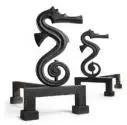Chasing Seahorses

My latest little journey took me no further than the keyboard on my laptop — and introduced me to one of the most memorable characters who ever played a role in the Arts and Crafts movement.
While you may well recognize L. Frank Baum as the author of the immortal The Wonderful Wizard of Oz, Baum had an important collaborator back in 1900, an illustrator by the name of William Wallace Denslow. Together they created the first edition of The Wonderful Wizard of Oz, first released in 1900 as a children’s novel featuring Denslow’s illustrations.
But just prior to teaming up with Baum, whom he later battled in a series of bitter lawsuits over the lucrative royalties the Great Wizard had bestowed upon these two men, William Denslow was, of all things, a Roycrofter.
Denslow was a character, and Elbert Hubbard had a penchant for characters who, like himself, didn’t always fit in with high society. Denslow loved cigars, whiskey and women, an affliction which often prompted him to hit the open road. He paid a high price for his aberrant lifestyle, leaving in his wake three ex-wives and a son he never met.
But his skill as a cartoonist, book designer and illustrator never seemed to leave him wanting for work. He bounced from newspaper to newspaper, supplementing his income illustrating Montgomery Ward mail order catalogs and book covers for publishing giant Rand McNally. In 1896 he got word of a long-haired writer and self-publisher by the name of Elbert Hubbard, who had sold his stock in the Larkin Soap Company for today’s equivalent of a quarter of a million dollars and started a small business by the name of the Roycroft Press.
After a brief exchange of letters, William Denslow turned up in East Aurora sometime in 1897. Never one to let the grass grow under his feet, we aren’t sure just when and for how long he stayed on the Roycroft Campus, but from 1897 until 1899 William Denslow’s signature seahorse showed up on an assortment of Roycroft title pages, book covers and magazine designs.
Denslow and Hubbard were born less than a month apart in 1856 and, in a stroke of historical irony, died just a few weeks apart in 1915. In 1897, the 41-year-old Denslow teamed up with another Roycroft convert, 24-year-old Jerome Connor, a talented sculptor who had also worked in a blacksmith shop and foundry before coming to East Aurora. Undoubtedly with the encouragement of Elbert Hubbard, Denslow designed a 14-inch tall seahorse, which we reason Jerome Connor sculpted into a model for a mold. At that point a local blacksmith by the name of Peter Robarge, whom Hubbard had hired to help build and furnish his latest buildings, became involved. Together Robarge and Connor cast and hammered out a small number of 19″ tall iron andirons featuring William Denslow’s seahorse atop a cast iron base.
We suspect the first seahorse andirons were offered for sale in 1899, but at a price of $50 (the equivalent of more than a month’s wages for a typical worker) and weighing in at 90 pounds for the pair (plus crating), it is no wonder few were ever sold.
Denslow, however, didn’t stick around to see how his seahorse andirons sold. By 1899 he was working with Baum on the final revisions for The Wonderful Wizard of Oz, which provided each man with a steady stream of royalties the remainder of their lives. Denslow, in fact, used his royalties from The Wonderful Wizard of Oz to buy Buck’s Island off Bermuda, where he crowned himself King Denslow I. In March of 1915, however, Denslow went on a drinking spree celebrating a new commission for a major magazine. That night he caught pneumonia and died a few days later on March 29, 1915.
His body was sent back to New York for burial beneath a tombstone decorated with his trademark seahorse.
And today serious Roycroft collectors keep their eye out for that same seahorse hiding in the corner of a title page of an early Roycroft book, or standing proudly atop a cast iron andiron, a lasting tribute to one of the earliest Roycrofters.

Until next Monday,
Have a great week!
Bruce
